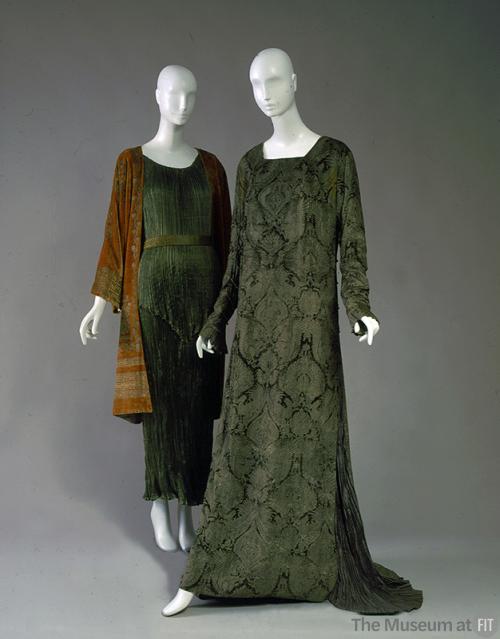
Mariano Fortuny
1871 - 1949
Mariano Fortuny was a painter, engraver, architect, photographer, lighting technician, inventor, and impresario who became known as the “Magician of Venice.” His biographer, Guillermo Osma, noted that Fortuny “was a rare mixture of scientist, artist and craftsman who personified the ideal of the Renaissance man in an age of increasingly narrow specialization.”
Be it a pleated “Delphos” gown or a printed velvet jacket, a Fortuny creation is instantly recognizable. His work can be found in museum costume collections around the world and clothing connoisseurs avidly collect it, yet Fortuny’s designs are not, strictly speaking, true fashion. Something of a fashion anomaly, Fortuny did not design styles that were constantly changing and evolving; rather, he created only a handful of clothing silhouettes that were variations on his finely pleated gowns and T-shaped jackets, and he intended that they be worn almost exclusively in intimate settings. However, though his range of clothing types was limited, the colors and patterns Fortuny used to adorn them were seemingly infinite.
Although Fortuny is often thought of as Venetian, he was born in Granada, Spain, in 1871, into an illustrious family of painters. Fortuny was just three years old when his father died, and soon thereafter his mother moved the family to Paris. In 1889, they moved again, this time to Venice, the city that became Fortuny’s adopted home. As a young man, he traveled throughout Europe, seeking out artists he admired, among them the German composer Richard Wagner.
It was in his Gothic Palazzo—home, studio, showroom, and think-tank—that Fortuny “invented” his Greek-inspired Delphos gown and Knossos scarf. Both were made using his mysterious, patented pleating process. Fortuny also created new methods of dying textiles, as well as ways of printing metallic dyes on fabrics, primarily silk velvets. While the technical processes were new, his dazzling patterns were culled from centuries past, most of them based on woven Italian velvets dating back to the Proto-Renaissance. So alluring was Fortuny’s work during his lifetime that French novelist Marcel Proust was moved to ask, “Is it their historical character, is it rather the fact that each one of them is unique that gives them so special a significance that the pose of the woman who is wearing one while she waits for you to appear or while she talks to you assumes an exceptional importance?"
Be it a pleated “Delphos” gown or a printed velvet jacket, a Fortuny creation is instantly recognizable. His work can be found in museum costume collections around the world and clothing connoisseurs avidly collect it, yet Fortuny’s designs are not, strictly speaking, true fashion. Something of a fashion anomaly, Fortuny did not design styles that were constantly changing and evolving; rather, he created only a handful of clothing silhouettes that were variations on his finely pleated gowns and T-shaped jackets, and he intended that they be worn almost exclusively in intimate settings. However, though his range of clothing types was limited, the colors and patterns Fortuny used to adorn them were seemingly infinite.
Although Fortuny is often thought of as Venetian, he was born in Granada, Spain, in 1871, into an illustrious family of painters. Fortuny was just three years old when his father died, and soon thereafter his mother moved the family to Paris. In 1889, they moved again, this time to Venice, the city that became Fortuny’s adopted home. As a young man, he traveled throughout Europe, seeking out artists he admired, among them the German composer Richard Wagner.
It was in his Gothic Palazzo—home, studio, showroom, and think-tank—that Fortuny “invented” his Greek-inspired Delphos gown and Knossos scarf. Both were made using his mysterious, patented pleating process. Fortuny also created new methods of dying textiles, as well as ways of printing metallic dyes on fabrics, primarily silk velvets. While the technical processes were new, his dazzling patterns were culled from centuries past, most of them based on woven Italian velvets dating back to the Proto-Renaissance. So alluring was Fortuny’s work during his lifetime that French novelist Marcel Proust was moved to ask, “Is it their historical character, is it rather the fact that each one of them is unique that gives them so special a significance that the pose of the woman who is wearing one while she waits for you to appear or while she talks to you assumes an exceptional importance?"

